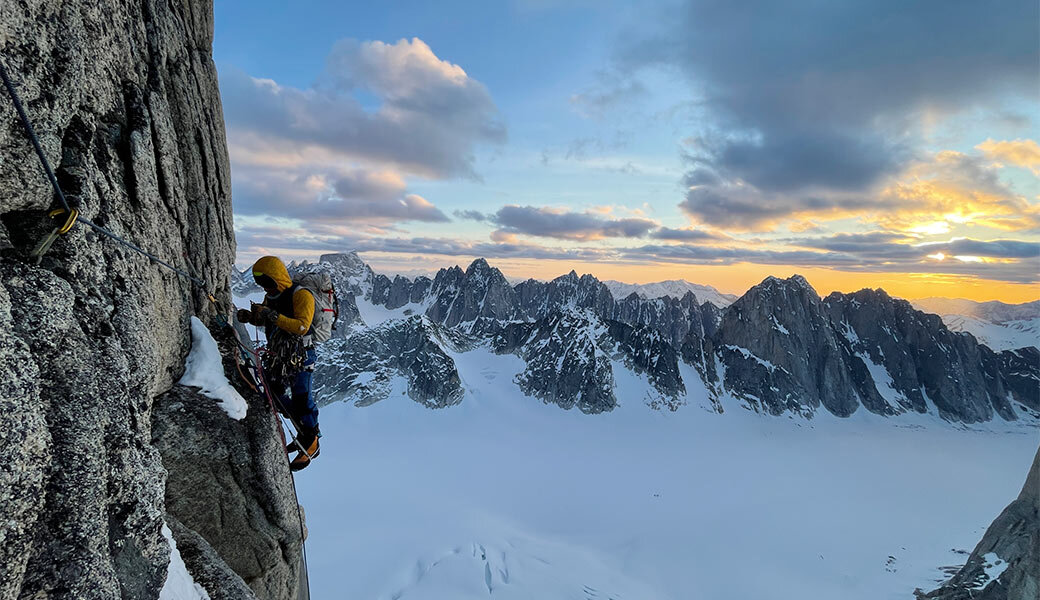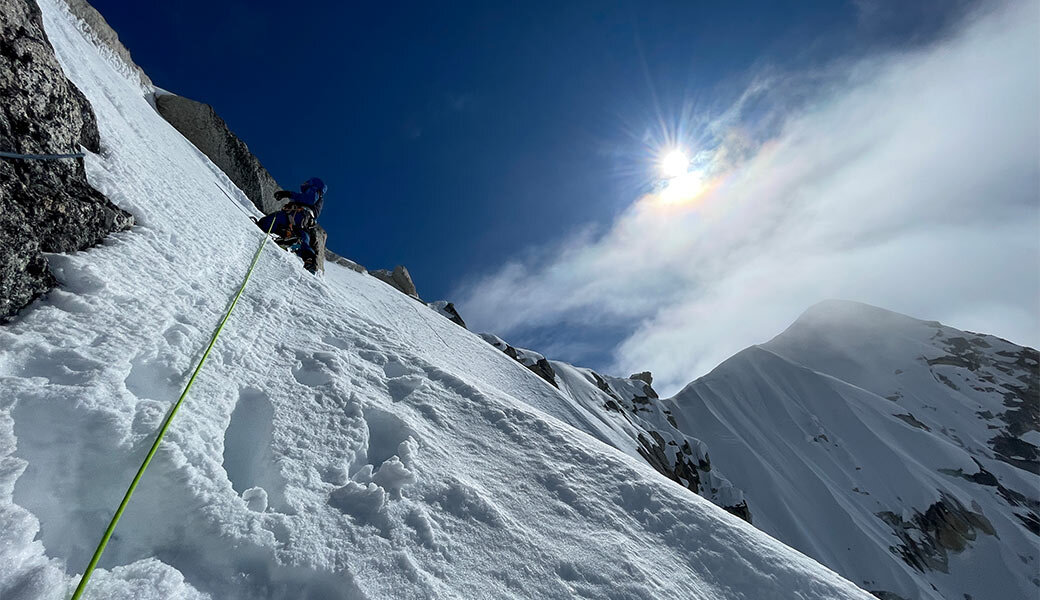SOUTHWEST RIDGE, K6 WEST (7040M), PAKISTANI KARAKORAM (M6, 90 DEGREES, 1800M)
This new route, opened during the 2015 season by Graham and his partner Scott Bennett was the
culmination of an excellent trip to the Pakistan Karakoram, during which they also made the first ascent of
Changi Tower via its North Ridge with Steve Swenson.
For this ascent of K6 West, Bennett and Zimmerman were awarded the American Alpine Club's Cutting
Edge Award for Excellence in Alpinism.
Career Highlights
NORTHWEST FACE, KICHATNA SPIRE, ( VI 5.10, A3+, M6, 70° snow)
From 23 - 27 May 2022, David Allfrey, Whit Magro and Graham Zimmerman established a new alpine,
big wall route on the Northwest Face of Kichatna Spire in the Alaska Range. It was Zimmerman's second
expedition to the face. The original was his first expedition in 2008.
SOUTH EAST FACE LINK SAR (7041M), PAKISTANI KARAKORAM, (M6+, WI4, 90° 2300M)
From July 31st to August 8th, 2019, Graham, along with Steve Swenson, Chris Wright, and Mark Richey,
made the first ascent of Link Sar (7,041 meters) in the Central Pakistani Karakoram via its 3,400-meter
Southeast Face. Having been the object of at least nine expeditions, the first ascent of this peak has
been a highly sought-after prize for the climbing community. The team is calling their route the Southeast
Face (M6+ WI 4 90°, 2300m), but the grade does a poor job of portraying the challenge of this route that
Karakoram veteran Swenson calls"one of the most complex and difficult routes I have ever climbed"

EAST FACE, MT LAURENS, ALASKA, (AI4 M7 A1, 1400M)
Allen and Zimmerman were recognized as the top 4 Piolet d'Or finalists for their 2013 ascent of Mount
Laurens (3,052m) in the Alaska Range. The two were likely the first to visit the southwest fork of the
Lacuna Glacier, from which they made two attempts on the direct East Buttress and finally succeeded
and climbed the northeast buttress in a 67-hour round trip push.
Interview
-
Climbing
When and how did you get into climbing and what kept you interested / fascinated in the
sport?I was first exposed to climbing at the age of 16. By the time I was 18, I was hooked and moved back down to New Zealand where I cut my teeth in the Southern Alps.
What were the most important milestones in your life so far, both in climbing and in
everyday life? Did you immediately recognize them as such or only later on?The most important milestone in my life was most certainly marrying my wife Shannon. She is my rock an my reason to make good decisions in the mountains.
What were your greatest failures / setbacks / injuries? How did you cope with them and
how did you come back from them?I have suffered a number of serious injuries in the mountains. They have consistently been a reminder
that the mountains are dangerous and when traveling through them we must always be vigilant. -
Training
Do you have a strict training schedule for when and how you train throughout the year?
My training, sleep and diet are all strictly regimented. Outside of climbing I take on significant work in climate advocacy and I work hard to be a good husband. This means that the time I have to train and climb has to be diligent and focused. It is a process that I love.
What advice can you give to somebody looking to improve their training routine?
I have always found that having a clear goal allows me back into an effective training plan. Additionally, when your body needs rest due to injury, illness or deep fatigue, give it a break.
What do you think of indoor climbing gyms in relation to climbing on actual rock?
Climbing gyms have made the practice of climbing far more accessible to a broad spectrum of folks. In opinion, the more people falling in love with climbing, the better, so I think gyms are great. To be clear, while I value climbing outside and in the big mountains, I don’t think there is anything wrong with folks focusing their energy on climbing indoors.
Are you able to do a one-arm pull-up? How about a single finger? How much of the success as a pro climber is due to show and how much due to actual climbing skill?
The alpine is a place that doesn’t let you hide much. While I don’t consider myself to be a “natural,” the mountains have been a place where I am able to apply dedication, grit and focus - which has resulted in a number of ascents that have inspired folks. It continues to be a powerful and fun journey.
-
Psychology
How to you deal with extremely hard climbing problems? Do you ever get frustrated and
give up on them or do they motivate you even more?When it comes to extreme hazard, I tend to shy away. The mountains are dangerous at the best of times. My goal is survive and climb hard throughout a long full life, this means being very diligent with how I manage hazard.
-
Future of climbing
Where do you think sport will go in the next few years? What will change? And what role will you play in it?
Climbing is getting broader and more diverse is many incredible ways. We as a community are learning how to use our voice and learning to create change. These are fabulous developments about which I am very excited.




